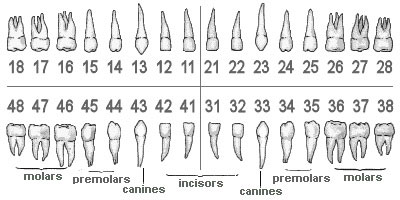Tooth numbering system is used by dentists for uniquely identifying and referring to a specific tooth. Over the years, over 20 different teeth numbering systems have been developed. Today, we use the following FDI tooth numbering systems for the numbering of the teeth.
FDI World Dental Federation Two-Digit Notation (international)
This system developed by the Fédération Dentaire Internationale (FDI), World Dental Federation notation is also known as ISO-3950 notation. The human teeth are symmetrically arranged in the mouth. Each quadrant of the mouth has 8 different teeth that are mirrored horizontally and vertically to the other quadrants.
In the FDI (Fédération Dentaire Internationale) World Dental Federation notation each one of these 8 teeth is assigned a number from 1 to 8, starting from the center front tooth (central incisor) and moving backwards up to the third molar (number 8). Each quadrant is also assigned a number, from 1 to 4 for the adult (permanent) teeth or 5 to 8 for the baby (primary or deciduous) teeth.
| Quadrant codes | Tooth codes | ||
| Adult teeth 1 upper right 2 upper left 3 lower left 4 lower right |
Baby teeth 5 upper right 6 upper left 7 lower left 8 lower right |
1. central incisor 2. lateral incisors 3. canines 4.1st premolars |
5. 2nd premolars 6. 1st molars 7. 2nd molars 8. 3rd molars |
| upper right | upper left |
 |
|
| lower right | lower left |
| Orientation of the FDI two-digit tooth numbering chart is traditionally "dentist's view", i.e. patient's right corresponds to tooth chart's left side. The designations "left" and "right" on the chart, however, correspond to the patient's left and right, respectively. | |
 Australia : 02 8103 4082
Australia : 02 8103 4082
 New Zealand : 0 9884 9783
New Zealand : 0 9884 9783
 Thailand : 0 2664 2800
Thailand : 0 2664 2800
 Int'l phone: +66 2105 4288
Int'l phone: +66 2105 4288
32/5 Sukhumvit 21 (Asok Road) Wattana Bangkok 10110 Thailand
Tel : 02 664 2800
EMAIL : contact@bangkokinterdental.com